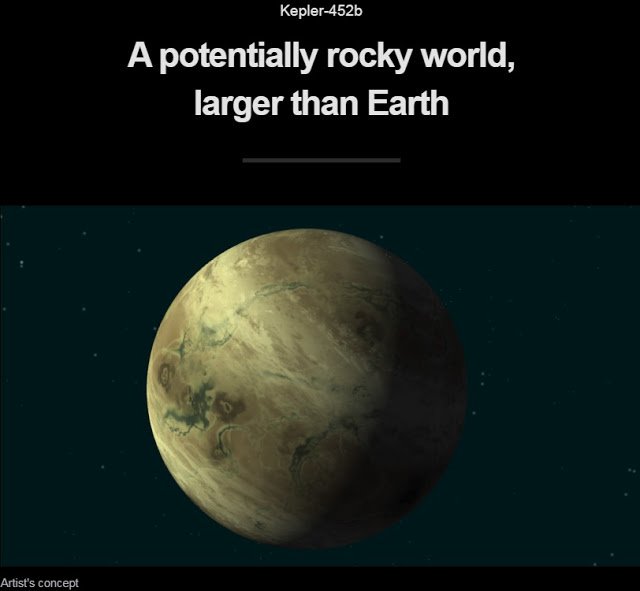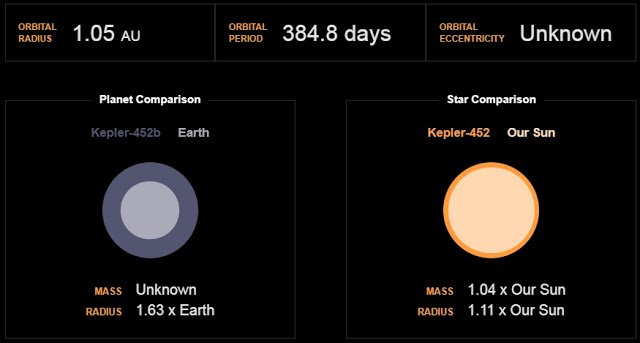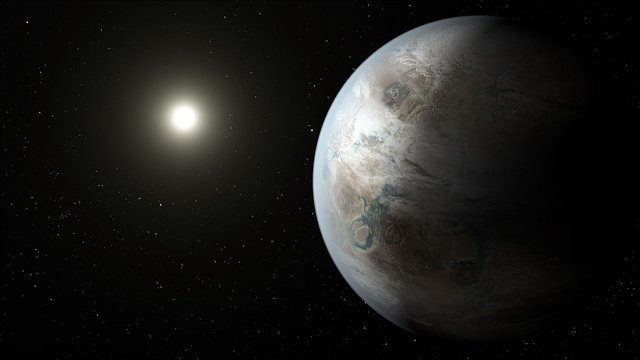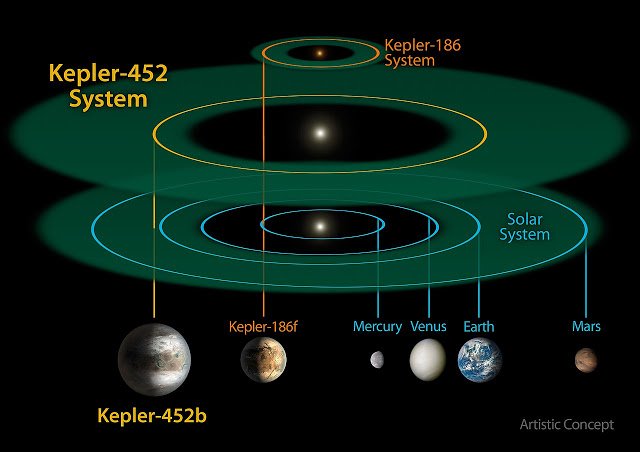Exoplanet Kepler-452b (Earth 2.0)
 Discovered: 2015. Planet type: Super Earth.
Discovered: 2015. Planet type: Super Earth.
Kepler-452b is the first near-Earth-size world to be found in the habitable zone of a star that is similar to our sun. Until its discovery in 2015, the Kepler telescope had only detected 12 Earth-size planets (smaller than twice the size of Earth) in the habitable zone of their smaller and cooler stars. Kepler-452b is the first planet orbiting a star about the same size and temperature as the sun.
When looking for planets that might support life, scientists start with the habitable zone. The habitable zone is a region around a star where temperatures are right for a water-an essential ingredient for life as we know it to pool on the surface. Scientists don’t know if #Kepler-452b can support life. What is known about the planet is that it is about 60 percent larger than Earth, placing it in a class of planets dubbed "super-Earths," with an orbit of 385 days. Scientists believe that Kepler-452b is about 6 billion years old, much older than #Earth.

Detection Method: Transit
If a planet passes directly between a star and an observer's line of sight, it blocks out a tiny portion of the star's light, thus reducing its apparent brightness.
Sensitive instruments can detect this periodic dip in brightness. From the period and depth of the transits, the orbit and size of the planetary companions can be calculated. Smaller #planets will produce a smaller effect, and vice-versa. A terrestrial planet in an Earth-like orbit, for example, would produce a minute dip in stellar brightness that would last just a few hours.
 Artist's concept of a rocky Earth-sized exoplanet in the habitable zone of its host star, possibly compatible with Kepler-452b’s known data.
Artist's concept of a rocky Earth-sized exoplanet in the habitable zone of its host star, possibly compatible with Kepler-452b’s known data.
Mass, radius, and temperature
Kepler-452b has a probable mass five times that of Earth, and its surface gravity is twice Earth's, though calculations of mass for #exoplanets are only rough estimates. If it is a terrestrial planet, it is most likely a super-Earth with many active volcanoes due to its higher mass and density. The clouds on the planet would be thick and misty, covering much of the surface as viewed from #space.
The planet takes 385 Earth days to orbit its star. Its radius is 50% bigger than Earth's and lies within the conservative habitable zone of its parent star. It has an equilibrium temperature of 265 K (−8 °C; 17 °F), a little warmer than Earth.
Host star
The host star, Kepler-452, is a G-type star that is about the same mass of the Sun, only 3.7% more massive and 11% larger. It has a surface temperature of 5757 K, nearly the same as the Sun, which has a surface temperature of 5778 K. The star's age is estimated to be about 6 billion years old, about 1.4 billion years older than the Sun, which is 4.6 billion years old. From the surface of Kepler-452b, its star would look almost identical to the #Sun as viewed from the Earth.
The star's apparent magnitude, or how bright it appears from Earth's perspective, is 13.426; therefore, it is too dim to be seen with the naked eye.
Orbit
Kepler-452b orbits its host star with an orbital period of 385 days and an orbital radius of about 1.04 AU, nearly the same as Earth's (1 AU). Its host star, #Kepler-452, is about 20% more luminous than the Sun (L = 1.2 L☉).
Kepler-452b is not tidally locked.
 A diagram of the orbit of Kepler-452b within the Kepler-452 system, as compared to the inner Solar System and Kepler-186 system, and their respective projected habitable zones.
A diagram of the orbit of Kepler-452b within the Kepler-452 system, as compared to the inner Solar System and Kepler-186 system, and their respective projected habitable zones.
SETI targeting
Scientists with the SETI (Search for Extraterrestrial Intelligence) Institute have already begun targeting Kepler-452b, the first near-Earth-size world found in the habitable zone of a Sun-like star. #SETI Institute researchers are using the Allen Telescope Array, a collection of 6-meter (20 feet) telescopes in the Cascade Mountains of California, to scan for radio transmissions from Kepler-452b. As of July 2015, the array has scanned the exoplanet on over 2 billion frequency bands, with no result. The telescopes will continue to scan over a total of 9 billion channels, searching for #alien radio signals.
Thank you for the interesting material!